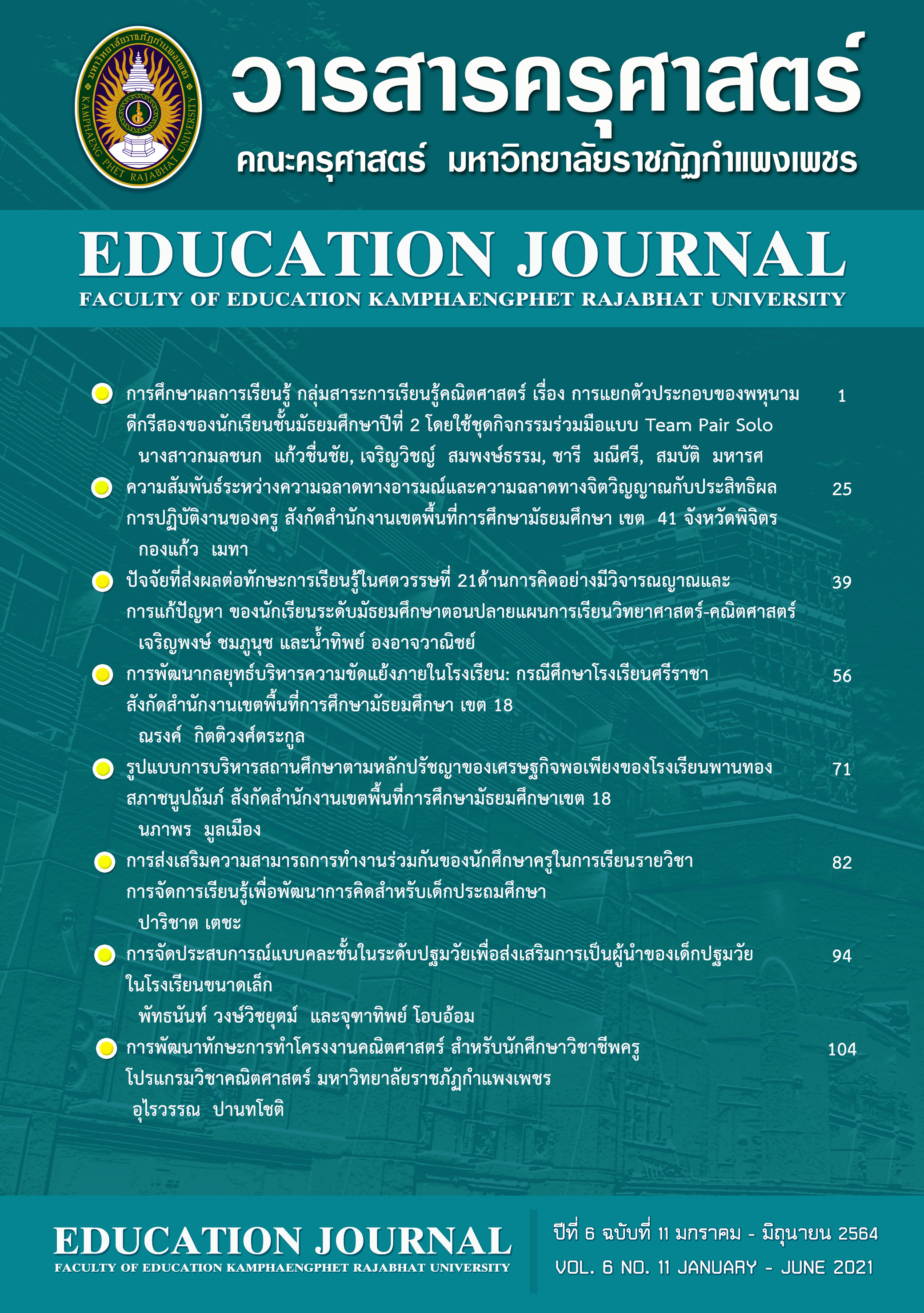STRATEGIES FOR DEVELOPING OF CONFLICT MANAGEMENT OF ADMINISTRATIVE IN SCHOOL : A CASE STUDY OF SRIRACHA SCHOOL UNDER THE SECONDARY EDUCATIONAL SERVICE AREA OFFICE 18
Main Article Content
Abstract
The purposes of this research are 1) to study of conflict management administrative in school: a case of Sriracha school Under Secondary Education Area Office Area 18 2) to develop strategies of conflict management for school 3) to study effects of strategies of conflict management in school. Phase 1, the sample were 355 of teachers, parents and the basic education school committee respondents which calculated by Taro Yamane’ formula and confidence level at 95 percent. Phase 2, the population was 13 expert to evaluate the strategies of conflict management. Phase 3, the sample were 369 of teachers, parents and the basic education school committee respondents which calculated by Taro Yamane’ formula and confidence level at 95 percent. The research instrument was questionnaire and the quality evaluation strategies of conflict management form. The data was analyzed by frequency, percentage, mean, standard variation and content analysis. The results found that: 1. The conflict management administrative in school follow:
1.1 Past situation, the conflict management administrative in school as a whole were at a high level. The conflict management in school occur in participation in decision-making at the high level, conflict arising from differences in person, idea, attitude and experience levels of conflict management of school administrators under the Secondary Education Area Office Area 18 was at a high level, centralization and share competition for resources was the least level. Resulting in inconsistency between the groups, image of the school is not good and destroying the morale and morale of the worker. The conflict management of administrator that most principals use for solving the problems is avoiding and collaboration was the least level 2. The conflict management administrative in school developing for this study composes of 4 main strategies, 12 plans and 52 projects/activities. These 4 main strategies are enhancing the efficiency of the principals, improving teachers and staffs competency to be professional, creating a positive education institution environment and motivation and establishing education institution system that has good governance. 3. The result of the implementation of conflict management strategies within the school found that; 1) quality of students, administrative process and management of school administrator, Student-centered Learning and Teaching are excellent quality 2) the satisfaction of related parties to the strategies of conflict management of administrative in school: A case study of Sriracha school Under The Secondary Educational Service Area Office were at a high level.
Article Details

This work is licensed under a Creative Commons Attribution-NonCommercial 4.0 International License.
CC Attribution-NonCommercial-NoDerivatives 4.0
References
เกรียงศักดิ์ เจริญวงศ์ศักดิ์. (2561). อารยสามัคคี: พลังสามัคคีบนฐานความดี ความงาม ความจริง. เข้าถึงได้จาก ttp://www.kriengsak.com/node/2364 วันที่สืบค้น 9 ธันวาคม 2561.
ข่าวช่องวัน. (2561). นักเรียนชุมนุมไล่ ผอ.โรงเรียน . [วีดิทัศน์] เข้าถึงได้จาก https://web.facebook.com/onenews31/posts/1635572043197931/?_rdc=1&_rdr (13 กุมภาพันธ์ 2561).
เขมมารี รักษ์ชูชีพ. (2553). ทฤษฎีองค์การ. กรุงเทพฯ : ทริปเปิ้ล กรุ๊ฟ.
ชนินทร์ ไวถนอมสัตว์. (2556). ยุทธศาสตร์การสร้างความสมานฉันท์ภายในโรงเรียน : กรณีศึกษาโรงเรียนดำรงราษฎร์สงเคราะห์. การศึกษาอิสระครุศาสตร์มหาบัณฑิต. สาขาวิชาการบริหารการศึกษา, บัณฑิตวิทยาลัย, มหาวิทยาลัยราชภัฏเชียงราย.
ชลบุรีทีวีออนไลน์ (2561). นักเรียนประท้วงไล่ผอ.โรงเรียนชื่อดังในอำเภอศรีราชา. [วีดิทัศน์] เข้าถึงได้จาก https://web.facebook.com/watch/?v=375532169584378 (13 กุมภาพันธ์ 2561).
ชัยเสฎฐ์ พรหมศรี. (2550). การจัดการความขัดแย้งในองค์กร. กรุงเทพฯ : เอ็กซเปอร์เน็ท.
ณรงค์ กังน้อย. (2555). ยุทธวิธีการจัดการความขัดแย้งของผู้บริหารโรงเรียน สังกัดสำนักงานเขตพื้นที่การศึกษาประถมศึกษานครปฐมเขต 1. วิทยานิพนธ์ปริญญามหาบัณฑิต. สาขาวิชาการบริหารการศึกษา, บัณฑิตวิทยาลัย, สถาบันราชภัฏนครปฐม.
ถวิล เกื้อกูลวงศ์. (2550). การบริหารการศึกษาสมัยใหม่ : ทฤษฎี วิจัย และการปฏิบัติ. กรุงเทพฯ : วัฒนพานิช.
ทองหล่อ เดชไชย. (2554). การบริหารความขัดแย้ง. เข้าถึงได้จาก http://www.novabizz.com/NovaAce/Relationship/Conflict_Management-2.htm.วันที่สืบค้น 9 ธันวาคม 2561.
ผู้จัดการออนไลน์. (2561). เรื่องไม่จบ กรณีนักเรียนชุมนุมไม่พอใจ ผอ.โรงเรียนศรีราชา. [วีดิทัศน์] เข้าถึงได้จาก https://mgronline.com/local/detail/9610000014839 (13 กุมภาพันธ์ 2561).
พรินศักดิ์ โพธิ์เผือก. (2557). ความสัมพันธ์ระหว่างการบริหารความขัดแย้งของผู้บริหารโรงเรียนกับความพึงพอใจของครูสังกัดสำนักงานเขตพื้นที่การศึกษาประถมศึกษาเพชรบุรี เขต 1. วิทยานิพนธ์ปริญญามหาบัณฑิต. สาขาวิชาการบริหารการศึกษาบัณฑิตวิทยาลัย, มหาวิทยาลัยราชภัฎเพชรบุรี.
พีพีทีวี. (2561). นักเรียนศรีราชาขับไล่ ผอ. โวยไม่พัฒนาโรงเรียนแถมเก็บเงินเพิ่ม [วีดิทัศน์] เข้าถึงhttps://www.pptvhd36.com/news/%E0%B8%9BE0%B8%A3%E0%B8%B0%E0%B9%80%E0%B8%94%E0%B9%87%E0%B8%99%E0%B8%A3%E0%B9%89%E0%B8%AD%E0%B8%99/75780 (13 กุมภาพันธ์ 2561).
มติชนออนไลน์. (2561). นักเรียน 1พันคน ประท้วงผอ.รร.ศรีราชา. [วีดิทัศน์] เข้าถึงได้จากhttps://www.matichon.co.th/education/news_840466 (13 กุมภาพันธ์ 2561).
วันชัย วัฒนศัพท์ และรัตนาภรณ์ วัฒนศัพท์. (2552). การแก้ปัญหาความขัดแย้งในสถานศึกษา. พิมพ์ครั้งที่ 3. กรุงเทพฯ: สถาบันพระปกเกล้า.
เสริมศักดิ์ วิศาลาภรณ์. (2540). 2540. ความขัดแย้ง : การบริหารเพื่อความสร้างสรรค์. กรุงเทพฯ :สำนักพิมพ์ต้นอ้อ.
อารีรัสมิ์ วัฒนทองผิว. (2553). การพัฒนากลยุทธ์การบริหารความขัดแย้งสำหรับสถานศึกษาของรัฐ. วิทยานิพนธ์ปริญญาครุศาสตรดุษฎีบัณฑิต. สาขาวิชาบริหารการศึกษา, ภาควิชานโยบาย การจัดการและความเป็นผู้นำทางการศึกษา, บัณฑิตวิทยาลัย, จุฬาลงกรณ์มหาวิทยาลัย.
Morrison, M. (1993). Professional Skill for Leadership. St.Louis : Mosby-year Book.
Stephen P. Robbins. (1990). Organization Theory : Structure Design and Application. 3rded. New Jersey : Prentice-Hall.


